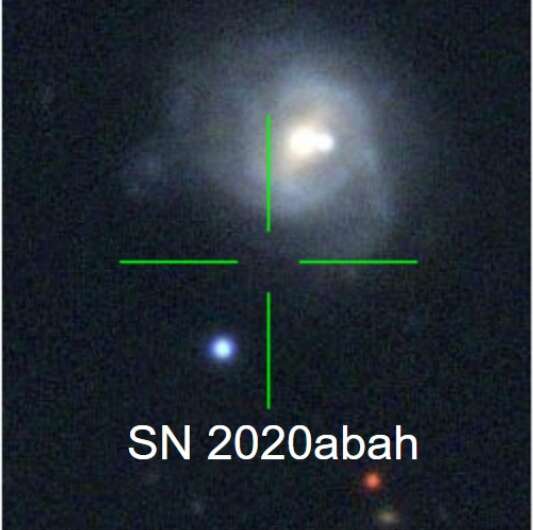
An international team of astronomers reports the detection of 12 new long-rising Type II supernovae as part of the Zwicky Transient Facility (ZTF) Census of the Local Universe (CLU). The discovery, published June 1 on the arXiv pre-print repository, nearly doubles the number of known supernovae of this subclass.
Type II supernovae (SNe) are the results of rapid collapse and violent explosion of massive stars (with masses above 8.0 solar masses). They are distinguished from other SNe by the presence of hydrogen in their spectra. Based on the shape of their light curves, they are usually divided into Type IIL and Type IIP. Type IIL SNe show a steady (linear) decline after the explosion, while Type IIP exhibit a period of slower decline (a plateau) that is followed by a normal decay.
Some Type II SNe are characterized by their unusual long rises to peak—lasting more than 40 days. Observations suggest that, in general, such long-rising SNe originate from more compact (with radii below 100 solar radii), massive (with masses of about 20 solar masses) stars, and have higher explosion energies. However, although three decades have passed since the discovery of the first long-rising Type II SNe, designated SN 1987A, only 16 explosions of this subclass have been identified in the local universe.
Recently, a group of astronomers led by Tawny Sit of the Ohio State University (OSU), has identified 13 long-rising Type II SNe (from a total of 3,444 transients), out of which 12 turned out to be new discoveries. The observations were conducted using the 48-inch Schmidt telescope (P48) at Palomar Observatory, under the ZTF CLU experiment.
The newfound Type II SNe have rise times ranging from 67 to 96 days and dome-shaped light curves in r-band photometry. They all have peak absolute magnitudes between −15.6 and −17.5 in the r-band, what is consistent with previous studies of the known long-rising Type II SNe.
The study found that all the 12 SNe have spectra showing broad hydrogen-alpha lines at velocities mostly consistent with those reported by previous observations of Type II Sne. Moreover, spectral lines of barium (Ba II) were detected in nine SNe reported in the paper.
The results indicate that the majority of the SNe II in the new sample occurred in environments with subsolar metallicities, in faint dwarf galaxies and in the outskirts of large star-forming galaxies. Two occurred in near- or super-solar metallicity environments.
Based on the CLU sample of events, the astronomers derive a long-rising Type II SNe rate of the total core-collapse supernovae (CCSNe). This value was calculated to be at a level of approximately 1.4%.
"With our derived rate of ≈1.4% of all CCSNe, we confirm that SN 1987A and similar SNe are indeed rare events," the authors of the study concluded.
More information: Tawny Sit et al, Long-rising Type II Supernovae in the Zwicky Transient Facility Census of the Local Universe, arXiv (2023). DOI: 10.48550/arxiv.2306.01109
Journal information: arXiv
© 2023 Science X Network
Citation: Astronomers discover 12 new long-rising Type II supernovae (2023, June 12) retrieved 12 June 2023 from https://ift.tt/unN4htH
This document is subject to copyright. Apart from any fair dealing for the purpose of private study or research, no part may be reproduced without the written permission. The content is provided for information purposes only.
"type" - Google News
June 12, 2023 at 08:17PM
https://ift.tt/57lCjSv
Astronomers discover 12 new long-rising Type II supernovae - Phys.org
"type" - Google News
https://ift.tt/BJZEl6K
https://ift.tt/Q6rOuZ0
Bagikan Berita Ini














0 Response to "Astronomers discover 12 new long-rising Type II supernovae - Phys.org"
Post a Comment